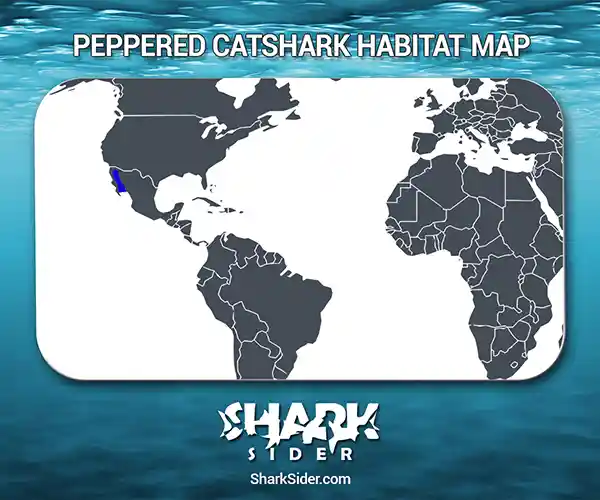The Peppered Catshark is a lesser-studied shark common in the Eastern Central Pacific. Stewart Springer and Mary Wagner first described it in 1966 in an issue of the Los Angeles County Museum Contributions in Science.
Peppered Catshark Scientific Classification |
|
| Kingdom | Animalia |
| Phylum | Chordata |
| Class | Chondrichthyes |
| Order | Carcharhiniformes |
| Family | Scyliorhinidae |
| Genus | Galeus |
| Scientific name | G. piperatus |
Description
This species is relatively small, with males growing to 28-29 cm (11-11.5 in) and females reaching a length of 26-30 cm (10-11.8 in). The largest specimen measured 37 cm (15 in) long.
Peppered catsharks get their name from their slender, grayish body dotted with dark spots. The juveniles may have dark brown saddles with white edges. The dorsal and caudal fins lack dark edges, and the tail is white-tipped.
They have a flat head, a long, pointy snout, and a large, wide mouth with narrow cusped teeth and a dark interior. The oval-shaped eyes have rudimentary nictitating membranes, and the frontal portions of the nostrils expand into triangular flaps. They have five gill slits. The dermal denticles are small and overlapping, forming a crest over the upper caudal margin.
The pectoral fins are broad and rounded, while the pelvic and anal fins are small, low, and angular. The two dorsal fins are similar-sized with blunt tips. The first is placed behind the pelvic fins, and the second originates from the middle of the anal fin. The caudal peduncle is horizontally flattened, leading to a long, low tail having a notched tip and a small lower lobe.
Where do they live
Map Of The Peppered Catshark’s Habitat

This shark is endemic to the Gulf of California in the eastern Pacific Ocean. It inhabits deep waters as far south as Guaymas in Sonora and Isla Salsipuedes in Baja California (26°N-32°N). Its isolated habitat was likely caused by the formation of the Isthmus of Panama 3 million years ago, separating it from other similar species. This bottom-dwelling species prefers depths of 275-1,326 m (902-4,350 ft). However, there are reports of them as much as 100 m (330 ft) above the sea floor at night.
Behavior
Reproductive
These catsharks follow an oviparous mode of reproduction. Mating lasts from May to September, with females laying between 2-10 eggs depending on size and age. These egg cases are olive-green and measure 3.5 cm (1.4 in) long. Newborns are usually 7-8 cm (2.8-3.1 in) long. One study by Mathews (1984) states that females mature at 18 cm (7.1 in), while another by Compagno (1984) found them maturing at 26-30 cm (10-11.8 in) and males becoming sexually active at 28-29 cm (11-11.5 in).
Migratory
These fish participate in seasonal migrations, spending winter in colder, deeper southern waters. This behavior contradicts common migratory patterns seen in other fish inhabiting the Gulf and is related to reproductive activity in summer.
Adaptations
It shares evolutionary features such as keen senses, streamlined bodies, and sharp teeth with other sharks for hunting prey.
Human interactions
Due to their deepwater habitat, these fish pose no commercial interest to fisheries. There are no conservation efforts, and the IUCN categorizes them as “Least Concern” or “LC.”
